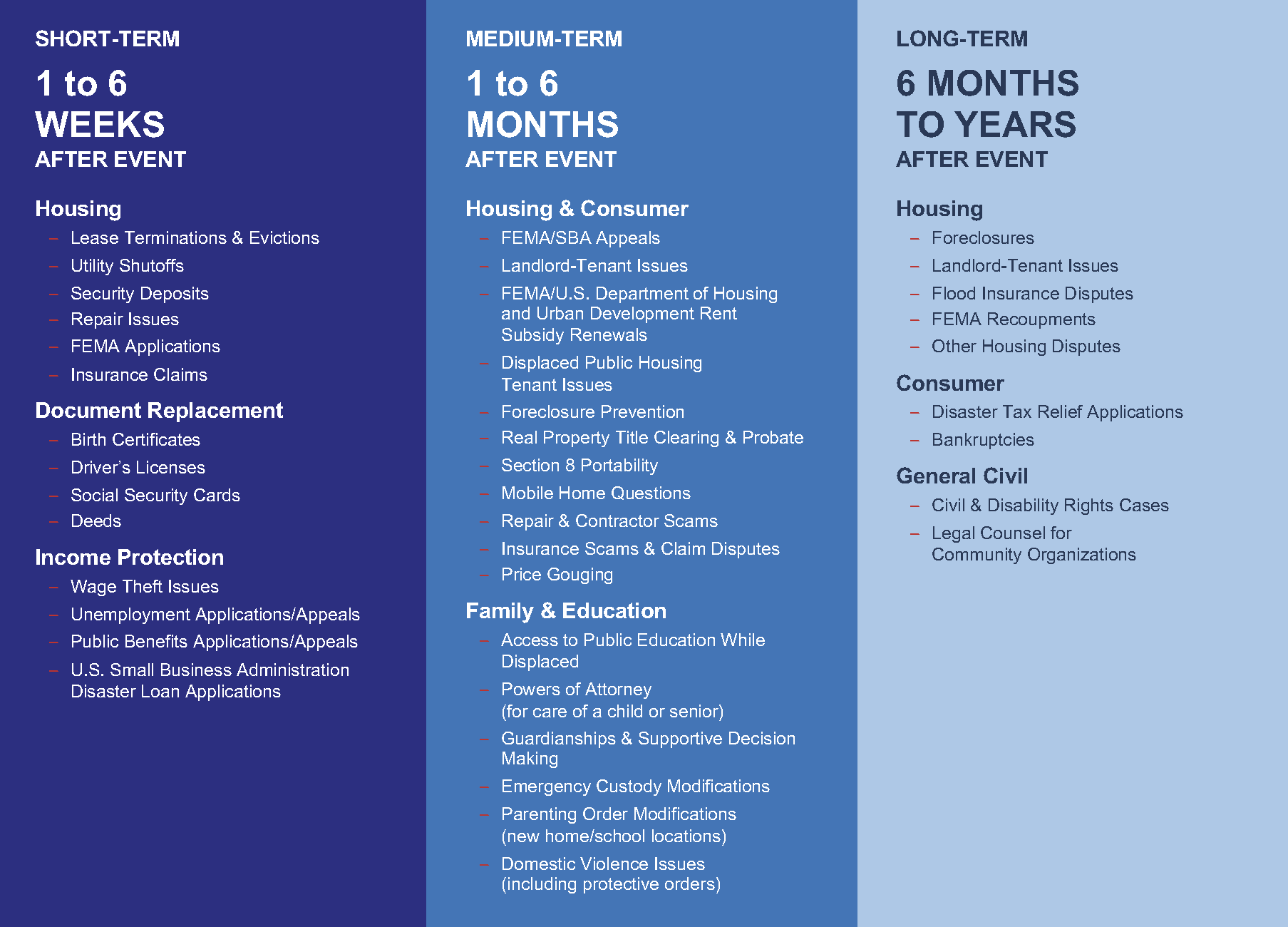Disaster Bootcamp
Prepare yourself to provide legal aid to disaster survivors. Find out what you need to know about disaster declarations, survivor assistance, common post-disaster issues, and ways to get involved.
Prepare yourself to provide legal aid to disaster survivors. Find out what you need to know about disaster declarations, survivor assistance, common post-disaster issues, and ways to get involved.
Page last updated: 04/20/2023
“Disaster” can be defined in many ways. In the strictest sense, Oxford Languages defines it as “a sudden event, such as an accident or a natural catastrophe, that causes great damage or loss of life.” Many disaster relief organizations define it in terms of survivor needs. For example, the International Federation of Red Cross and Red Crescent Societies defines disasters as “serious disruptions to the functioning of a community that exceed its capacity to cope using its own resources.”
For the U.S. government, “major disaster” has a very specific meaning under federal law in terms of determining the need for federal assistance to a community and its residents. Under the federal government’s parameters, the term can apply to any natural catastrophe, such as a hurricane, tornado, storm, high water, wind-driven water, tidal wave, tsunami, earthquake, volcanic eruption, landslide, mudslide, snowstorm, or drought. It also can apply to any fire, flood, or explosion, regardless of cause, that “causes damage of sufficient severity and magnitude to warrant major disaster assistance.”
Under the Robert T. Stafford Disaster Relief and Emergency Assistance Act, PL 100-707, known as the Stafford Act, federal assistance for individuals becomes available when the president of the United States issues a major disaster declaration for an area, such as a county or counties. Under the Stafford Act:
The president can also issue an emergency declaration under a similar process. But federal aid under emergency declarations is almost always limited to public assistance to state, tribal, and local governments and certain private nonprofit organizations for emergency work and the repair or replacement of disaster-damaged facilities.
Note that although the term “major disaster” is used for presidential declarations, the government also often uses the single word “disaster” when referring to the assistance and programs the declaration can trigger.
The Federal Emergency Management Agency (FEMA) assistance under disaster declarations falls into three general categories:
The determination of which programs are authorized is based on the types of assistance specified in the governor’s or tribal government’s request and on the needs identified during the preliminary damage assessment.
Several other types of individual assistance — such as disaster legal services, unemployment, food security, and more — are provided or overseen by FEMA, the Small Business Administration (SBA), the U.S. Department of Agriculture, and the U.S. Department of Labor, typically in conjunction with local and state administration.
In your legal aid role, you will be concerned primarily with issues involving individual assistance. One of the major ways this assistance is provided is through FEMA’s Individuals and Households Program (IHP). IHP consists of two components: Housing Assistance (HA) and Other Needs Assistance (ONA). In some cases, FEMA aid is intertwined with SBA disaster loans.
Housing Assistance (HA)
Other Needs Assistance (ONA)
* SBA-dependent assistance is available only to individuals who do not qualify for an SBA disaster loan or did not receive a large enough loan to meet their needs.
It’s important to learn more about IHP assistance and the FEMA and SBA disaster loans processes so that you can better prepare yourself to provide legal assistance to survivors after a disaster.
To help people with the multiple issues they can face after a disaster, you also need to know about other forms of special assistance that typically become available from the federal government after a major disaster declaration (some of these also may be available after an emergency declaration). These forms of declaration-dependent assistance include:
FEMA’s Individual Assistance Program and Policy Guide (PDF) provides additional information on each of these programs, except D-SNAP. You can learn more about D-SNAP in LADRC’s Disaster Benefits guide for attorneys (PDF). This LADRC guide also includes information on many of the FEMA programs.
A disaster does not have to rise to the level of receiving a presidential disaster declaration to have a major impact on people in the affected area. After any disaster — declared or not — you may be called on to help low-income residents as a legal professional offering pro bono services.
After a disaster or crisis, disaster-related legal issues typically follow a common pattern. These issues may be addressed through federal aid or under federal or state laws.
Knowing what issues to expect can help you be better prepared to serve disaster survivors when these needs arise. You can use the list below to identify which issues you need or want to learn more about and how jurisdiction applies.
Common Post-Disaster Legal Issues, by Jurisdiction
Here are some key points to keep in mind if you want to make yourself available to help survivors of any disaster:
Life Cycle of Post-Disaster Civil Legal Issues
